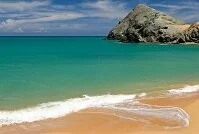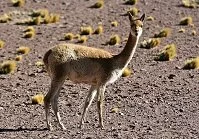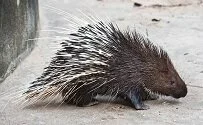Wildlife

La Guajira
Colombia has a very diverse variety of wildlife since the country has landscapes that include tropical coastline to the high Andes Mountains as well as the beginnings of the Amazon River, which is a rain forest in the country's southeast. These differences in geography and weather attract a large number of animals and allow many different plants to grow.
Many of the more common mammals are woodland animals, such as squirrels, mice, rats, bats, opossums, deer, rabbits, tapirs, sloths, and others. However, the mountains and rain forests attract these animals as well as others, including llamas, alpacas, vicunas (a camel species), cougars (puma), beers, armadillos, porcupines, monkeys, jaguars, and wolves. There are also some rodents unique to South America in Colombia, such as the chinchilla and capybara.
Colombia also has a huge variety of sea life in the Caribbean Sea, the Pacific Ocean, and in the rivers that lead to the Amazon River. The saltwater bodies are home to mammals, like whales, dolphins, and manatees as well as fish, shellfish, and coral reefs. The corals bring in a lot of different animals, including surgeonfish and butterfly fish. Other animals roaming these waters include sharks, marlins, tuna, barracuda, mahi-mahi, snapper, mackerel, grouper, puffer fish, shrimp, crabs, seahorses, starfish, eels, rays, jellyfish, and sea urchins. In the fresh waters, including the rivers flowing east are additional species of fishes. The sea life here includes trout, pike, catfish, and others, but these animals aren't as diverse as much of the Amazon River.

Vicuna
The bird life is almost as diverse as the sea life since woodland, mountain, sea, and rain forest birds are all common. Among these are egrets, eagles, condors, partridges, coots, geese, sandpipers, ibis, herons, finches, hummingbirds, toucans, macaws, wrens, owls, sparrows, cardinals, jays, orioles, frigate birds, pigeons, parrots, parakeets, flamingos, and woodpeckers.
The reptilian, amphibian, and insect life in Colombia are also diverse, but the variety of species is still somewhat limited. Many of these animals are spiders, including the tarantula and black widow, and snakes, including the rattlesnake, boa, and anaconda. In or near some of the rivers, especially those in the rainforests, the amphibian population spikes as a number of frogs, iguanas, and lizards are present. The number of insects is quite substantial, including flies, mosquitos, butterflies, ants, and more.

Porcupine
When it comes to native plant life, South America is home to many famous edible plants and these plants quickly spread throughout Colombia, South America, and beyond. The pineapple is from the region where Brazil and Uruguay meet while potatoes and tobacco originated in the Andes Mountains. A few others, including cacao trees (used to make chocolate), peanuts, and tomatoes are also from South America, although their actual origin is unknown. Peppers, both sweet and hot peppers are from Central America or northern South America while vanilla, avocado, papaya, and corn (maize) are likely from Central America itself. No matter each food's origin, what is known is that these foods spread throughout the continent and to the country of Colombia with the help of pre-historic people, animals, and winds. These people have had these foods for nearly as long as people have inhabited the region and each makes an important part of the people's diet and culture now and for thousands of years into the past.
Many other plants are also present in Colombia. Orchids, lilies, rosewood trees, mahogany trees, mangrove trees, rubber trees, walnut trees, cedar trees, oak trees, and thousands of other trees, flowers, ferns, and plants can be found in Colombia.